The study tour to the United States is a key component of the core course. Dr Sven Brenner, a participant, shares his impressions from Washington, D.C. and New York City.
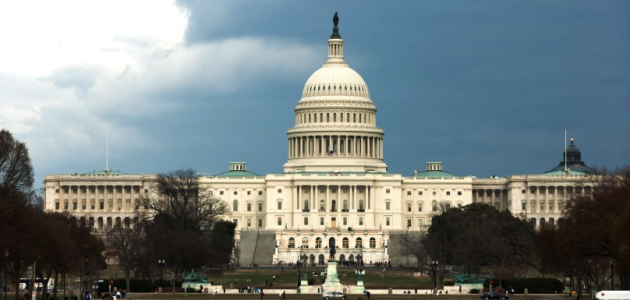
The study tour took the Federal Academy for Security Policy’s (BAKS) core course to national and international meetings in the U.S. capital Washington, D.C., and to the United Nations’ headquarters in New York City. Shown here: the United States Capitol, the seat of the U.S. Congress. Picture: Krzysztof Belczyński/Flickr/CC BY-SA 2.0
The 2018 core course’s journey to the United States revealed a deeply divided country. A visit to the U.S. administration showed that the U.S. is attempting to defend its position in the new world order, yet is hard-pressed to find viable responses to concrete challenges. Despite a very busy schedule, we managed to find time to reflect and do some “bourbon sharing” outside of our discussions about burden-sharing. The main focuses of our talks with U.S. and international representatives were as follows:
1. Burden-Sharing
The U.S. expects the members of NATO, and particularly Germany, to adhere to the objectives defined at NATO’s Wales Summit in September 2014, which call for members to increase their defence budgets to two percent of their gross domestic products by 2024. From this standpoint, Germany has a major responsibility for NATO and needs to invest more in its own security rather than counting on a “free ride” from the U.S. As the U.S. sees it, Germany has a strong economy and has no right to prioritise other policy areas at the U.S.’s expense while neglecting its national defence. It is a matter of sharing the burdens of security policy, often referred to simply as “burden-sharing”. The people we met with adamantly argued that, if Germany does not provide appropriate Bundeswehr forces, the U.S. will charge fees for the military capabilities it uses to keep the peace. Hardly any thought is given to a diplomatic approach, and transatlantic relations are extremely tense.
2. The Iran Deal
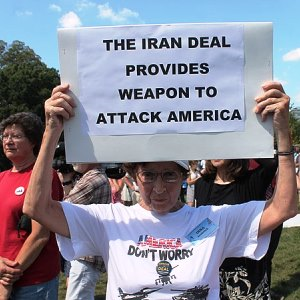
U.S. protest against the Iran nuclear deal may come as a surprise to Europeans. Picture: Elvert Barnes/Wikimedia Commons/CC BY-SA 2.0
Many people we met with in the U.S. see the Joint Comprehensive Plan of Action (commonly known as the Iran nuclear deal or Iran deal) as a “bad deal” that only benefits Iran. In their eyes, Tehran is getting more access to the global economy and can develop its economy and trade, but is still able to work on its nuclear programme under the guise of the deal. From this standpoint, it is the worst possible solution. Accordingly, its opponents believe that Iran must be forced to stop its nuclear weapons programme forever. Our discussions made it abundantly clear that the political conflicts of the late 1970s continue to affect the relations between the United States and Iran, and that the U.S. sees Iran as a major threat. This aspect dominates discussions. Iran is supposedly playing a significant role in the main problems in the Middle East, particularly the Syrian conflict. The people we spoke to had no answer to the question of whether a “bad deal” isn’t better than no deal at all, in other words, whether Iran wouldn’t be more able to work on its nuclear programme than ever if there were no agreement and it no longer had to put up with the relevant inspections. It became clear during our stay that the U.S. would withdraw from the Iran deal, which it did as we were leaving.
3. The Belt and Road Initiative and China’s Role in Geopolitics
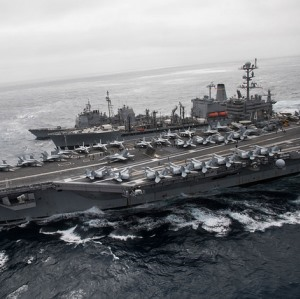
America is investing heavily in its military presence in the Asia-Pacific region. But what could an overall strategy for dealing with the rise of China look like? Picture: US Pacific Fleet/Flickr/CC BY-NC 2.0
The U.S.’s answer to China’s Belt and Road Initiative, also known as the “New Silk Road”, is the free and open Indo-Pacific strategy. However, this strategy has yet to take shape. The United States’ offer to the countries in the Indo-Pacific region is that any of them is welcome to pursue a common trade and security strategy with the U.S. The name indicates a special focus on India, but also Australia. Smaller countries that feel surrounded, overlooked or left behind by China’s Belt and Road Initiative are particularly welcome.
The United States is concerned about the growing debts many countries have to China, even though the U.S. itself is one of Beijing’s biggest debtors. Many people we spoke to in the U.S. were pleased about China’s investments, especially in Africa. At the same time, they find it unacceptable for China not to think about the consequences of these investments, and say the Trump administration is probably not going to put up with that much longer. More than once, we heard people saying that China’s investments seem very deliberately designed to make other countries dependent on the People’s Republic through debt. Overall, the U.S. seems to realise that “the sun rises in the east” is taking on new meaning, and it is (again) a new dawn for East Asia. However, there are only the most rudimentary indications of a systematic, progressive strategy that goes beyond military power projection. On the whole, the U.S. administration seems to have no coherent answer to the rise of China.
4. North Korea
In geopolitical terms, North Korea is closer to the US than Iran is. Despite its recent backpedalling, the Trump administration seems to see a deal with North Korea as far more important than an agreement with Iran. North Korea is a very real threat to U.S. operations in Southeast Asia. North Korea’s proximity to US military bases in South Korea, Japan and the US insular area Guam makes Pyongyang a very concrete threat to the U.S., unlike Tehran. That is why a North Korea deal would be a logical solution for the Trump administration. However, it also became very clear that the U.S. continues to see military solutions as completely appropriate and practicable.
5. Trumpism
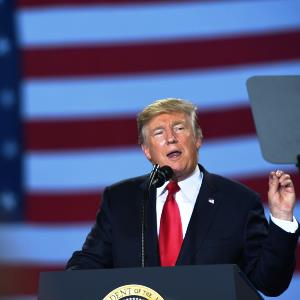
An unconventional president: ostensible success in domestic policy coupled with impulsive actions. Picture: U.S. Air National Guard Staff Sgt Tony Harp/Air Force Special Operations Command
Under the new president, the country seems to be both suffering and thriving. The federal executive departments seem unsettled. The usual administrative rules no longer apply. It seems like even the administration gets its orders from the president on Twitter. Anyone who doesn’t “fit” gets replaced. Trump’s domestic policy seems to be succeeding. The unemployment rate is four percent. There was a tax reform that significantly reduced the tax burden on higher and lower incomes, and brought a considerable amount of foreign capital into the country through retroactive taxation. This tax reform will mean the end of the health insurance system introduced under President Obama because it repeals the penalty for those without insurance, which was intended to increase the number of people insured. The resulting lack of healthy young insurance policy holders is sounding a death knell for Obamacare. Trump is fulfilling the promises he made in his campaign. “Make America Great Again” is also manifesting itself in the punitive tariffs imposed on aluminium and steel. Even though the U.S. is completely incapable of meeting its own demand for steel and aluminium, the tariffs are well-received by the population because they mean that American work is worth something again. It became very clear that Trump is an outsider and not part of the Washington establishment. The federal executive departments still don’t seem to have found a professional way of working with this president.
Overall Impression: Driving by Sight
Our discussions often showed signs of an attitude that sees other countries less as allies than as vassals: anyone who, like the United States, is against Iran, Russia, China or North Korea had better fall in line with the U.S. or risk no longer being considered an ally. The world’s policeman is feeling worse for the wear, and discussions can get heated. Hardly anyone is willing to listen to ideas for other approaches, standpoints or objections. The U.S. administration seems to be acting on impulse. It is not weighing consequences or analysing ramifications. For example, the U.S. embassy in Israel was moved to Jerusalem for no apparent reason and in violation of a UN resolution, without any thought for the consequences or the possibility of a diplomatic impasse. National and global problems are solved as they come up. Later problems are initially ignored, while the administration repeatedly considers the option of military intervention. There is no strategic approach based on any vision of the future. The “here and now” seems to take centre stage. No concrete vision of how the global community should look in the future exists. How allies will act in future remains to be seen, but it looks like the end of a close transatlantic relationship that has lasted more than 60 years.
A Point of Contrast: The United Nations
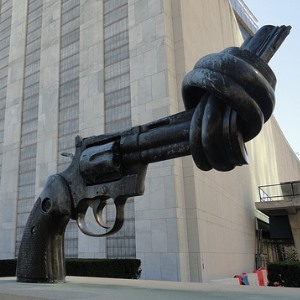
A symbol of peace: the “Non-Violence” sculpture in front of the UN headquarters. Picture: Saed Abu Hmud/pixabay/CC0
Our visit to the United Nations was a point of contrast where we encountered a more positive image of Germany. The Federal Republic of Germany is not a “free-rider”, but rather the biggest financial supporter and therefore a reliable partner of the UN. Germany’s diplomatic efforts are appreciated, and it is almost certain to become a non-permanent member of the UN Security Council for the 2019 to 2020 term.
The main topics of our discussions in New York were peacekeeping, development policy and migration. It became apparent that the UN works solely with the least common denominator of all its partners, yet manages to succeed in some ways despite the veto powers’ different interests. For example, it managed to pass the Agenda 2030 with the 17 Sustainable Development Goals. Nevertheless, its limits become very clear when the Security Council’s veto powers have conflicting interests. “It’s never been this hard to find common ground” is something we kept hearing. UN Secretary-General Guterres is trying to reform the UN. However, the question is whether this global organisation only (still) exists because there are veto powers that can enforce their interests. If there were resolutions against the interests of China, Russia or the U.S. and there were no veto rights in the Security Council, would these countries still be members of the organisation? The reform process must take this question into account.
It also became clear that, if Germany pursues a stronger role in the UN, let alone a permanent seat in the Security Council, there would have to be honest, strategic discussion of Germany’s security policy and its responsibility to the global community – including military duties. Financial resources for diplomacy, the military and development policy also have to be taken into account in this process. At the same time, objectives the UN has set and negotiated itself, such as climate protection, should not remain mere principles.
Author: Dr Sven Brenner. This article reflects his personal opinions.
